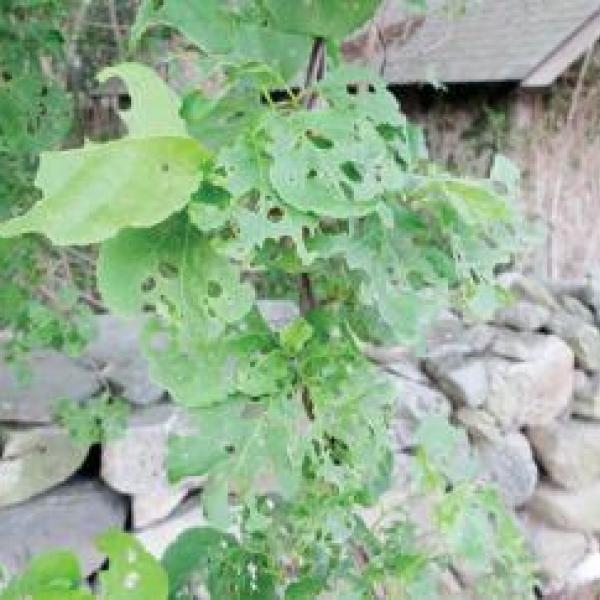
News Source
People all over town are asking, what is happening to our trees?
Oak, maple and fruit tree leaves are disappearing. Nowhere is this more noticeable than along the access road from the Jamestown Bridge.
According to Jim Rugh, chairman of the town tree committee, the culprit is a small green worm, the larvae of the winter moth.
“They are those dirty gray moths you see around lights in the winter, hence the name,” said Rugh.
The European pest was introduced into Canada sometime before 1930 and has been slowly spreading. They were found in Rhode Island about 2005 and reached Jamestown in 2010.
Tiny, young, light-green caterpillars hatch in early spring and tunnel into and feed inside buds. According to the University of Rhode Island, the average hatch date is April 10.
The larvae feed in the expanding leaf clusters, and as the pests increase in size, they consume all but the mid-rib of the leaves. It is difficult to control the caterpillars, says Rugh, because they are feeding on leaves after the buds have opened.
There is good news, however. Rugh says the insects are reaching the end of their life cycle. By mid-June, the caterpillars will stop feeding and migrate to the soil. They will stay there in a pupa stage until they emerge in late November as adult winter moths. After mating, the female deposits egg clusters on tree trunks and branches. In spring, the eggs hatch and the cycle begins again.
Click Here
Injured trees will try to re-foliate, Rugh said. New leaves start appearing after four to six weeks, but they are fewer and smaller than the originals. A full recovery will rest on the tree’s ability to create and store enough energy over the rest of the summer. Research in Canada has shown that it takes four consecutive years of complete defoliation to kill a tree.
Water is critical to trees at this time of the season, said Rugh, and that poses a special problem in Jamestown. Because of the dry spring and rare rain in the summer, supplemental watering of trees will be necessary. Trees require much more water than lawns, so automatic watering systems are not much help. According to Rugh, to determine how much water a tree needs, measure the diameter at chest height. A small tree will be 1 to 7 inches in diameter, and a medium tree will be 8 to 15 inches in diameter. Anything bigger is considered a large tree.
The University of Colorado has a formula to determine how much water a tree needs. They suggest adding approximately 10 gallons of water per inch of trunk diameter for each week when it does not rain. Using a hose at medium pressure, it takes approximately five minutes to produce 10 gallons of water.
In the village, there is normally a summer water ban, which should be observed, Rugh said. Therefore, residents will need to prioritize. Grass may brown, but it will revive. Trees with moderate leaf loss will survive. Only the most defoliated are at risk.
Rugh says not to use sprinklers or surface watering for trees because it will waste much of the water. For small and medium trees, residents can use a tree irrigation bag available at many nurseries and hardware stores. Drilling holes in a 5-gallon bucket, filling it with water, and letting the water slowly drain out is another technique.
For large trees, Rugh said, a soaker hose draped around the tree within the drip line works well, but the water will need to be adjusted. Residents can also purchase a deep root irrigator. It’s attached to a hose, pushed into the ground, and it puts the water in the root zone.
According to Rugh, there is good news in the long term. In Canada, a parasitic fly that only attacks winter moth larvae was released beginning in 1954. By 1962, winter moths in Canada were under control. They are still present, but only in small numbers. With the exception of apple orchards, they do little damage to our neighboring trees to the north.
In 2005 and 2006, hundreds of the parasitic flies were released in Massachusetts. Rhode Island soon followed. A release was made in Jamestown in 2013. It will take several years for the fly population to increase to a point where they have an impact on the winter moths, says Rugh.